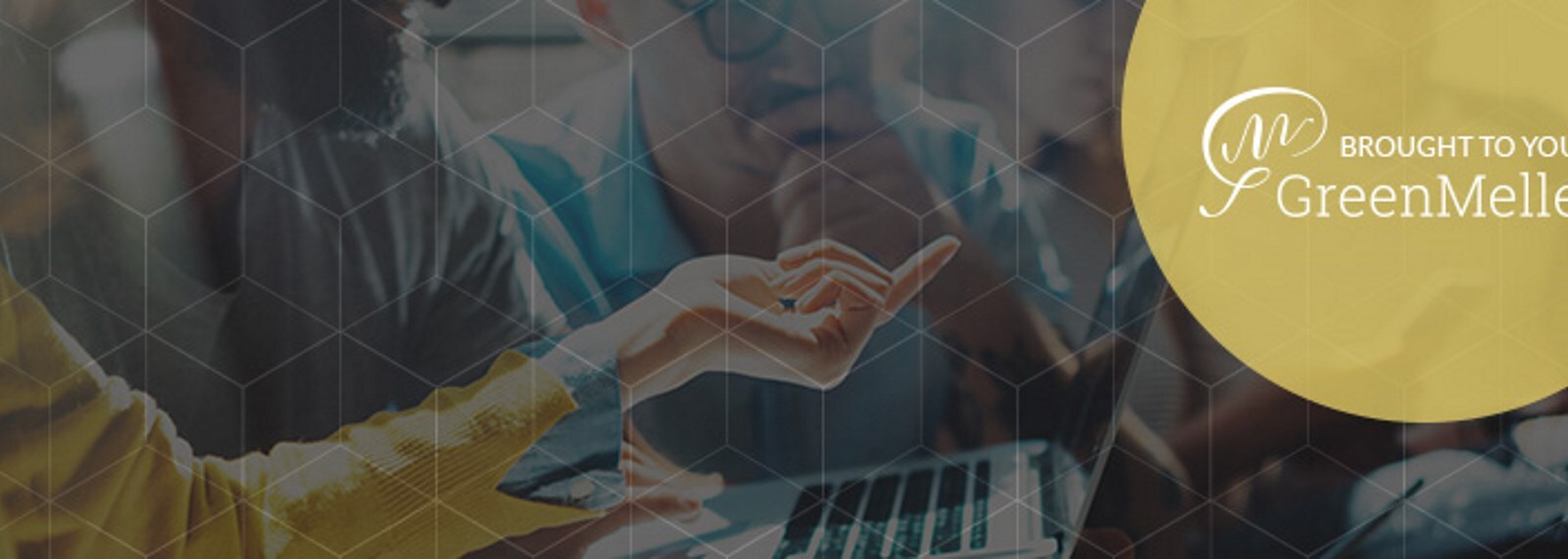

8.5K
Downloads
85
Episodes
Running a business is daunting. There are too many things to keep track of and everything seems to cost money. So how do you actually grow your company without going crazy or broke? At GreenMellen, we understand the challenges of being business owners. As a digital marketing agency for over a decade, we've got experience helping businesses grow using the latest technology and marketing best practices. The Brighter Web podcast is aimed at sharing practical advice. The show is hosted by GreenMellen partner Mickey Mellen & marketing manager Robert Carnes. Join us to learn about effective organizational processes and digital marketing insights.
Episodes

Thursday May 23, 2024
Project Management with Brooke Desmond
Thursday May 23, 2024
Thursday May 23, 2024
Even if it’s not in your job title or description, you’re likely somewhat familiar with project management. However, it’s not a responsibility everyone fully understands or embraces. This makes project management one of the most underrated and underappreciated parts of business and marketing. We invited GreenMellen’s project manager, Brooke Desmond, on to discuss how we can all improve our project management.

Thursday May 09, 2024
Marketing Agencies with Ali Green
Thursday May 09, 2024
Thursday May 09, 2024
What is it like to start and run a marketing agency? Our co-host Mickey Mellen invites his co-founder Ali Green to the show to discuss building GreenMellen together. This is a peek behind the curtain of how a digital marketing agency works and what it takes to operate smoothly.

Thursday Apr 25, 2024
Search Engine Optimization with Bobby Kircher
Thursday Apr 25, 2024
Thursday Apr 25, 2024
Is SEO still relevant to marketers, especially with recent changes with technology? The short answer is yes, and we invited search expert Bobby Kircher to discuss why. Let’s make search optimization practical and achievable for small businesses like yours.
Links
- Bobby’s website: https://bobbykircher.com/
- Papaya Search: https://papayasearch.com/
- Bobby on LinkedIn: https://www.linkedin.com/in/bobbykircher/

Thursday Apr 11, 2024
Content Marketing with Adam Walker
Thursday Apr 11, 2024
Thursday Apr 11, 2024
Is your small business struggling with content marketing? In this episode, we invited on our friend Adam Walker to talk about repurposing content for different platforms. These simple tips will help you scale your marketing strategy to reach a wider audience and save time.
Links
- Adam’s Website: https://adamjwalker.com/
- Tech Talk Ya’ll on Spotify: https://podcasters.spotify.com/pod/show/techtalkyall/
- Together Letters: https://www.togetherletters.com/
- Edgewise Media: https://edgewise.media/
- Adam’s Newsletter on Substack: https://adamjwalker.substack.com/
- Adam on LinkedIn: https://www.linkedin.com/in/adamjwalker/

Thursday Dec 21, 2023
Special Announcement: A New Podcast Format
Thursday Dec 21, 2023
Thursday Dec 21, 2023
After 60 episodes of the Brighter Web podcast, we're changing things up. Starting in 2024, we're bringing guests to the show and talk about digital marketing topics. We'll be back in a few months with some new, slightly different-sounding episodes.

Thursday Dec 07, 2023
Optimizing Website Conversions to Grow Your Business
Thursday Dec 07, 2023
Thursday Dec 07, 2023
There’s no shortage of digital metrics to measure, but conversions are perhaps the most important. These are the actions that actually help your business to grow. But how do you measure and improve your conversions online?
What are website conversions?
- Form fill
- Download a file
- Watch a video
- Purchase
- Donate
What is conversion optimization?
- Making adjustments to your website to get people to take a desired action
- It’s an ongoing process that you must test and adjust
- Rand Fishkin (Sparktoro) - Precise attribution is hard to measure. Share our Blumer story.
- Less attribution, more refinement of optimization
Why does conversion matter?
- Because these are the actions to help your business grow
- Without a desired action, what are you aiming for?
- This is where the true value of marketing comes in
How do you get people to convert more?
- Pick a single call to action
- Make it clear how to take action
- Focus the content on the page around the action
- Give people multiple opportunities to click a call to action
- Make small changes and test to see how people react — A/B testing
How do you measure conversion rates?
- Count the number of conversions
- Count the number of website users
- Divide the former by the later
- You can also divide up the specific types of conversions
- This can be done directly in Google Analytics 4 (with help from Google Tag Manager)
Do platforms outside of your website influence conversions?
- Yes! It matters how people view your brand before seeing your website.
- It matters what landing page they come to
- It matters how many times & ways they’ve encountered your brand

Thursday Nov 23, 2023
10 Ways to Monetize Your Digital Marketing Content
Thursday Nov 23, 2023
Thursday Nov 23, 2023
The internet is about far more than just making money—but that’s certainly something you can do. Content creators have found plenty of ways to earn income from the digital stuff they make.
This list is far from comprehensive, but here are 10 big buckets of ways to make money from the content you create online.
- Selling a service (like GreenMellen)
- Website development
- Coaching or consulting
- Graphic design
- Freelance writing
- Selling a physical product online
- E-commerce
- Swag
- Books
- Selling a digital product
- Ebooks and resources
- WordPress themes
- WordPress plugins
- Document templates
- Selling an online course
- Create a private membership forum
- Post Status
- Mighty Networks
- Private newsletter
- Accept donations
- Sponsorships
- Mostly for podcasts
- Directly on Anchor
- Website ads
- Google AdSense (and similar)
- Direct sponsorships
- Affiliate marketing
- Promoting products
- Getting a cut of the sales
- Amazon Affiliate links
- Publishing videos
- YouTube monetization
- Not just with ads, but to help promote other content

Thursday Nov 09, 2023
Creating an Effective Marketing Budget
Thursday Nov 09, 2023
Thursday Nov 09, 2023
Effecitve marketing requires an investment. For a business, this means creating and spending a marketing budget. But how much should you spend on marketing, and what return should you expect? There’s no one answer, so let’s examine the right approach.
Where do I start with my marketing budget?
- Figure out what you’ve spent to this point.
- Create a document to track everything and work with your accounting team.
- Develop an ideal budget for what you’d like to spend.
- Think big and work backward to what is realistic.
How much should I be spending on marketing?
- There’s no one right answer.
- It’s all about what’s most valuable to your business.
- This is much more than just advertising.
What categories should I consider?
- Marketing software/tech stack
- Content creation
- Advertising
- Networking events
- Sponsorships
How do I expand my marketing budget?
- Measure the ROI for what you’re seeing in return.
- Determine your most effective channels and increase there first.
- Look at the spend as an experiment—try something new and see if it works.
- Get your leadership’s buy-in so they understand the value.

Thursday Oct 26, 2023
Capitalizing on Networking Events for Marketing Growth
Thursday Oct 26, 2023
Thursday Oct 26, 2023
Digital marketing is useless without personal connections and word-of-mouth referrals. But is networking played out or ripe for you to take advantage of? It all depends on your approach.
How does networking help my marketing?
- Get to know people in a more casual setting.
- Face and name recognition can be as important as brand recognition.
- Build a relationship with people before you begin selling.
- You might also meet people who can help your business.
What kind of events can I network at?
- Conferences
- Tradeshows
- Panel discussions
- Volunteer opportunities
- Business happy hours
- Lunch & learns
What are some networking best practices?
- Attend events where you know who the audience will be.
- Focus on in-depth conversations with a few people.
- Are business cards still worth bringing? Yes, if you have them.
- Digital business cards are cool, but they break my process.
- I like receiving cards more than giving them.
- Follow up with people after you meet them—connect on LinkedIn.
Is it worth sponsoring networking events?
- Take a look at the cost and see if it fits into your budget.
- Determine the why behind your reason for being a sponsor.
- The reason might be exposure or trying to get more leads.
- It’s also good to get visibility in your local community.
What about speaking at events?
- Are you comfortable with public speaking?
- Do you feel like you have something of value to provide?
- What topic do people care about that you can help them with?
- Reach out to a few events that are actively looking for speakers.
Should I plan my own networking event?
- We do quarterly micro-networking events.
- This is with people we already know and want to introduce to each other.
- It’s fun for us and fun for them—that’s the point.
- This helps us to deeper our relationships and say thank you to our fans.

Thursday Oct 12, 2023
Our 6 Least Favorite Marketing Channels
Thursday Oct 12, 2023
Thursday Oct 12, 2023
There are plenty of great and effective digital marketing channels, but there are just as many bad ones. Or at least good channels that tend to be used poorly by lazy marketers. These are our six least favorite marketing channels.
Robert’s 3 least favorite
- Direct mail: because it’s usually useless and hard to track.
- Billboards: because no one looks at them while they’re driving.
- Twitter: because it’s been officially run into the ground.
Mickey’s 3 least favorite
- Spam email: Email marketing can be great, but it too often isn’t.
- Bogus LinkedIn connections: Don’t connect with me if I don’t know who you are.
- Unsolicited text messages: Texting should be personal, so stop bothering me.